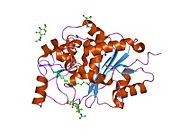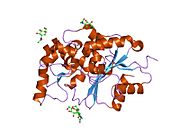Palmitoyl-protein thioesterase 1 (PPT-1), also known as palmitoyl-protein hydrolase 1, is an enzyme that in humans is encoded by the PPT1 gene.
Function
PPT-1 a member of the palmitoyl protein thioesterase family. PPT-1 is a small glycoprotein involved in the catabolism of lipid-modified proteins during lysosomal degradation. This enzyme removes thioester-linked fatty acyl groups such as palmitate from cysteine residues.
Clinical significance
Defects in this gene are a cause of neuronal ceroid lipofuscinosis type 1 (CLN1).
References
- ^ GRCh38: Ensembl release 89: ENSG00000131238 – Ensembl, May 2017
- ^ GRCm38: Ensembl release 89: ENSMUSG00000028657 – Ensembl, May 2017
- "Human PubMed Reference:". National Center for Biotechnology Information, U.S. National Library of Medicine.
- "Mouse PubMed Reference:". National Center for Biotechnology Information, U.S. National Library of Medicine.
- ^ "Entrez Gene: palmitoyl-protein thioesterase 1".
- Hellsten E, Vesa J, Speer MC, Mäkelä TP, Järvelä I, Alitalo K, Ott J, Peltonen L (June 1993). "Refined assignment of the infantile neuronal ceroid lipofuscinosis (INCL, CLN1) locus at 1p32: incorporation of linkage disequilibrium in multipoint analysis". Genomics. 16 (3): 720–5. doi:10.1006/geno.1993.1253. PMID 8325646.
- Vesa J, Hellsten E, Verkruyse LA, Camp LA, Rapola J, Santavuori P, Hofmann SL, Peltonen L (August 1995). "Mutations in the palmitoyl protein thioesterase gene causing infantile neuronal ceroid lipofuscinosis". Nature. 376 (6541): 584–7. Bibcode:1995Natur.376..584V. doi:10.1038/376584a0. PMID 7637805. S2CID 4322423.
- Genetic basis and phenotypic correlations of the neuronal ceroid lipofusinoses. Warrier V; Vieira M; Mole SE. Biochimica et Biophysica Acta. 1832(11):1827-30, 2013
Further reading
- Tsukamoto T, Iida J, Dobashi Y, et al. (2006). "Overexpression in colorectal carcinoma of two lysosomal enzymes, CLN2 and CLN1, involved in neuronal ceroid lipofuscinosis". Cancer. 106 (7): 1489–97. doi:10.1002/cncr.21764. PMID 16518810. S2CID 26004924.
- Simonati A, Tessa A, Bernardina BD, et al. (2009). "Variant late infantile neuronal ceroid lipofuscinosis because of CLN1 mutations". Pediatr. Neurol. 40 (4): 271–6. doi:10.1016/j.pediatrneurol.2008.10.018. PMID 19302939.
- Hofmann SL, Atashband A, Cho SK, et al. (2002). "Neuronal ceroid lipofuscinoses caused by defects in soluble lysosomal enzymes (CLN1 and CLN2)". Curr. Mol. Med. 2 (5): 423–37. doi:10.2174/1566524023362294. PMID 12125808.
- Kousi M, Siintola E, Dvorakova L, et al. (2009). "Mutations in CLN7/MFSD8 are a common cause of variant late-infantile neuronal ceroid lipofuscinosis". Brain. 132 (Pt 3): 810–9. doi:10.1093/brain/awn366. PMID 19201763.
- Weimer JM, Kriscenski-Perry E, Elshatory Y, Pearce DA (2002). "The neuronal ceroid lipofuscinoses: mutations in different proteins result in similar disease". Neuromolecular Med. 1 (2): 111–24. doi:10.1385/NMM:1:2:111. PMID 12025857. S2CID 33921126.
- Martins-de-Souza D, Gattaz WF, Schmitt A, et al. (2009). "Prefrontal cortex shotgun proteome analysis reveals altered calcium homeostasis and immune system imbalance in schizophrenia". Eur Arch Psychiatry Clin Neurosci. 259 (3): 151–63. doi:10.1007/s00406-008-0847-2. PMID 19165527. S2CID 33815571.
- Otsuki T, Ota T, Nishikawa T, et al. (2005). "Signal sequence and keyword trap in silico for selection of full-length human cDNAs encoding secretion or membrane proteins from oligo-capped cDNA libraries". DNA Res. 12 (2): 117–26. doi:10.1093/dnares/12.2.117. PMID 16303743.
- Kimura K, Wakamatsu A, Suzuki Y, et al. (2006). "Diversification of transcriptional modulation: Large-scale identification and characterization of putative alternative promoters of human genes". Genome Res. 16 (1): 55–65. doi:10.1101/gr.4039406. PMC 1356129. PMID 16344560.
- Zhang H, Li XJ, Martin DB, Aebersold R (2003). "Identification and quantification of N-linked glycoproteins using hydrazide chemistry, stable isotope labeling and mass spectrometry". Nat. Biotechnol. 21 (6): 660–6. doi:10.1038/nbt827. PMID 12754519. S2CID 581283.
- Calero G, Gupta P, Nonato MC, et al. (2003). "The crystal structure of palmitoyl protein thioesterase-2 (PPT2) reveals the basis for divergent substrate specificities of the two lysosomal thioesterases, PPT1 and PPT2". J. Biol. Chem. 278 (39): 37957–64. doi:10.1074/jbc.M301225200. PMID 12855696.
- Kim SJ, Zhang Z, Sarkar C, et al. (2008). "Palmitoyl protein thioesterase-1 deficiency impairs synaptic vesicle recycling at nerve terminals, contributing to neuropathology in humans and mice". J. Clin. Invest. 118 (9): 3075–86. doi:10.1172/JCI33482. PMC 2515381. PMID 18704195.
- Ramadan H, Al-Din AS, Ismail A, et al. (2007). "Adult neuronal ceroid lipofuscinosis caused by deficiency in palmitoyl protein thioesterase 1". Neurology. 68 (5): 387–8. doi:10.1212/01.wnl.0000252825.85947.2f. PMID 17261688. S2CID 44887575.
- Ahtiainen L, Van Diggelen OP, Jalanko A, Kopra O (2003). "Palmitoyl protein thioesterase 1 is targeted to the axons in neurons". J. Comp. Neurol. 455 (3): 368–77. doi:10.1002/cne.10492. PMID 12483688. S2CID 37821662.
- Gregório SP, Sallet PC, Do KA, et al. (2009). "Polymorphisms in genes involved in neurodevelopment may be associated with altered brain morphology in schizophrenia: preliminary evidence". Psychiatry Res. 165 (1–2): 1–9. doi:10.1016/j.psychres.2007.08.011. PMID 19054571. S2CID 43548414.
- Gerhard DS, Wagner L, Feingold EA, et al. (2004). "The Status, Quality, and Expansion of the NIH Full-Length cDNA Project: The Mammalian Gene Collection (MGC)". Genome Res. 14 (10B): 2121–7. doi:10.1101/gr.2596504. PMC 528928. PMID 15489334.
- Dawson G, Cho S (2000). "Batten's disease: clues to neuronal protein catabolism in lysosomes". J. Neurosci. Res. 60 (2): 133–40. doi:10.1002/(SICI)1097-4547(20000415)60:2<133::AID-JNR1>3.0.CO;2-3. PMID 10740217. S2CID 28786470.
- Goswami R, Ahmed M, Kilkus J, et al. (2005). "Differential regulation of ceramide in lipid-rich microdomains (rafts): antagonistic role of palmitoyl:protein thioesterase and neutral sphingomyelinase 2". J. Neurosci. Res. 81 (2): 208–17. doi:10.1002/jnr.20549. PMID 15929065. S2CID 21060010.
- Strausberg RL, Feingold EA, Grouse LH, et al. (2002). "Generation and initial analysis of more than 15,000 full-length human and mouse cDNA sequences". Proc. Natl. Acad. Sci. U.S.A. 99 (26): 16899–903. Bibcode:2002PNAS...9916899M. doi:10.1073/pnas.242603899. PMC 139241. PMID 12477932.
- Kim SJ, Zhang Z, Lee YC, Mukherjee AB (2006). "Palmitoyl-protein thioesterase-1 deficiency leads to the activation of caspase-9 and contributes to rapid neurodegeneration in INCL". Hum. Mol. Genet. 15 (10): 1580–6. doi:10.1093/hmg/ddl078. PMID 16571600.
- Ahtiainen L, Luiro K, Kauppi M, et al. (2006). "Palmitoyl protein thioesterase 1 (PPT1) deficiency causes endocytic defects connected to abnormal saposin processing". Exp. Cell Res. 312 (9): 1540–53. doi:10.1016/j.yexcr.2006.01.034. PMID 16542649.
External links
This article incorporates text from the United States National Library of Medicine, which is in the public domain.
| PDB gallery | |
|---|---|
| Thioesterases (EC 3.1.2) | |
|---|---|
| Acetyl-CoA thioesterases |
|
| Acyl-CoA thioesterases | |
| Formyl-CoA thioesterases |
|
| Palmitoyl protein thioesterases | |
| Succinyl-CoA thioesterases |
|
| Ubiquitin C-terminal hydrolases | |
| Enzymes | |
|---|---|
| Activity | |
| Regulation | |
| Classification | |
| Kinetics | |
| Types |
|
This article on a gene on human chromosome 1 is a stub. You can help Misplaced Pages by expanding it. |







